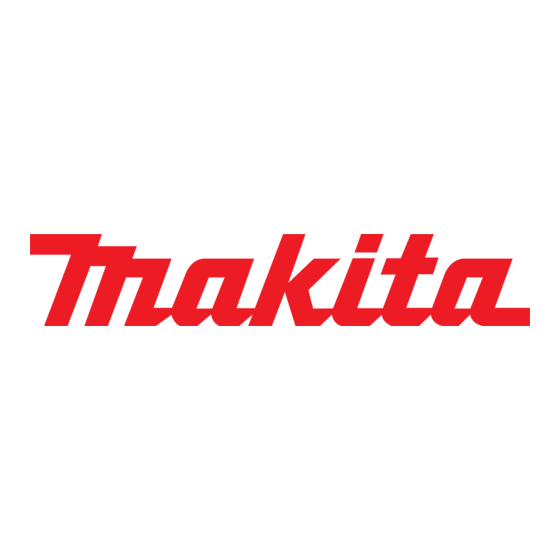Makita BCS550 Gebrauchsanweisung - Seite 4
Blättern Sie online oder laden Sie pdf Gebrauchsanweisung für Elektrowerkzeug Makita BCS550 herunter. Makita BCS550 12 Seiten. Cordless metal cutter 136mm (5-3/8")
Auch für Makita BCS550: Aufschlüsselung der Teile (3 seiten), Gebrauchsanweisung (13 seiten), Gebrauchsanweisung (10 seiten), Technische Informationen (13 seiten)

22. Keep cutting tools sharp and clean. Properly
maintained cutting tools with sharp cutting edges
are less likely to bind and are easier to control.
23. Use the power tool, accessories and tool bits
etc. in accordance with these instructions,
taking into account the working conditions
and the work to be performed. Use of the power
tool for operations different from those intended
could result in a hazardous situation.
Battery tool use and care
24. Recharge only with the charger specified by
the manufacturer. A charger that is suitable for
one type of battery pack may create a risk of fire
when used with another battery pack.
25. Use
power
tools
designated battery packs. Use of any other
battery packs may create a risk of injury and fire.
26. When battery pack is not in use, keep it away
from other metal objects, like paper clips,
coins, keys, nails, screws or other small metal
objects, that can make a connection from one
terminal to another. Shorting the battery
terminals together may cause burns or a fire.
27. Under abusive conditions, liquid may be
ejected from the battery; avoid contact. If
contact accidentally occurs, flush with water. If
liquid contacts eyes, additionally seek medical
help. Liquid ejected from the battery may cause
irritation or burns.
Service
28. Have your power tool serviced by a qualified
repair person using only identical replacement
parts. This will ensure that the safety of the power
tool is maintained.
29. Follow
instruction
changing accessories.
30. Keep handles dry, clean and free from oil and
grease.
CORDLESS METAL CUTTER
SAFETY WARNINGS
DANGER:
1.
Keep hands away from cutting area and the
blade. Keep your second hand on auxiliary
handle, or motor housing. If both hands are
holding the tool, they cannot be cut by blade.
2.
Do not reach underneath the workpiece. The
guard cannot protect you from the blade below the
workpiece.
3.
Adjust the cutting depth to the thickness of
the workpiece. Less than a full tooth of the blade
teeth should be visible below the workpiece.
only
with
specifically
for
lubricating
and
GEB058-1
4.
Never hold piece being cut in your hands or
across your leg. Secure the workpiece to a
stable platform. It is important to support the
work properly to minimize body exposure, blade
binding, or loss of control.
5.
Hold
power
surfaces when performing an operation where
the cutting tool may contact hidden wiring.
Contact with a "live" wire will also make exposed
metal parts of the power tool "live" and shock the
operator.
6.
When ripping always use a rip fence or
straight edge guide. This improves the accuracy
of cut and reduces the chance for blade binding.
7.
Always use blades with correct size and shape
(diamond versus round) of arbour holes.
Blades that do not match the mounting hardware
of the tool will run eccentrically, causing loss of
control.
8.
Never
use
washers or bolts. The blade washers and bolt
were specially designed for your tool, for optimum
performance and safety of operation.
9.
Causes and operator prevention of kickback;
−
Kickback is a sudden reaction to a pinched,
bound or misaligned blade, causing an
uncontrolled tool to lift up and out of the
workpiece toward the operator.
−
When the blade is pinched or bound tightly by
the kerf closing down, the blade stalls and the
motor reaction drives the unit rapidly back
toward the operator.
−
If the blade becomes twisted or misaligned in
the cut, the teeth at the back edge of the
blade can dig into the top surface of the
workpiece causing the blade to climb out of
the kerf and jump back toward the operator.
Kickback is the result of tool misuse and/or
incorrect operating procedures or conditions and
can be avoided by taking proper precautions as
given below.
Maintain a firm grip with both hands on the
•
tool and position your arms to resist
kickback forces. Position your body to
either side of the blade, but not in line with
the blade. Kickback could cause the tool to
jump backwards, but kickback forces can be
controlled
precautions are taken.
When
blade
•
interrupting a cut for any reason, release
the trigger and hold the tool motionless in
the material until the blade comes to a
complete stop. Never attempt to remove
the tool from the work or pull the tool
4
tool
by
insulated
damaged
or
incorrect
by
the
operator,
is
binding,
gripping
blade
if
proper
or
when
